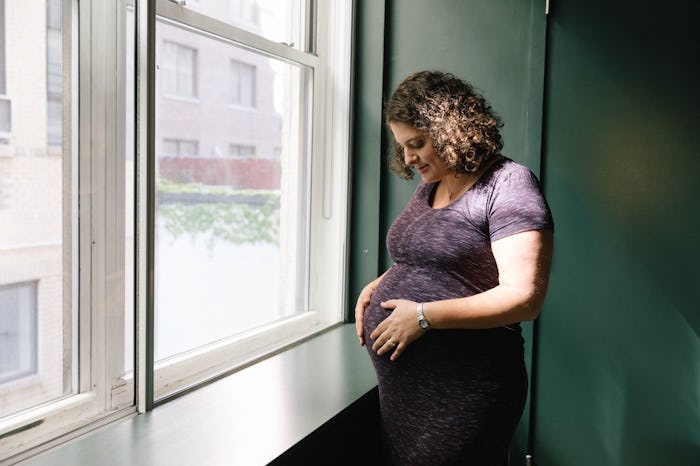When I was pregnant with my first I went days past my due date and, as you can imagine, I was frustrated. My daughter had dropped weeks prior, so every day it felt like I was carrying a bowling ball between my legs. But having your baby drop "early" isn't as bad as having your baby not drop at all. When I was pregnant with my second, my son, he seemed determined to stay put, lodged under my rib cage and nowhere near my cervix. That's when I learned how to get through pregnancy when your baby hasn't dropped because, well, I didn't have much of a choice.
As the Cleveland Clinic notes, the ideal place for your baby to be during delivery is head down and facing your back. So, starting in your last month of pregnancy, your provider will schedule regular checks to make sure that your soon-to-be baby is at least headed in the right direction. According to the American College of Obstetrics and Gynecology (ACOG), your baby dropping (also called lightening), or physically moving towards your birth canal, might actually happen weeks before labor... or not at all. In fact, as Heidi Murkoff, author of What to Expect When You're Expecting, notes, while feeling your baby drop is common with first pregnancies, most pregnant people won't notice a difference during their second or subsequent pregnancies, which might explain why my last two babies "didn't drop."
While it's natural to worry if your baby hasn't dropped, especially if you're getting close to and/or are past your due date, it's generally not a big deal. And, as always, your best bet is to ask your provider if everything looks good, and if you get a green light just wait for labor to start or ask about induction.
For more tips on dealing when your baby hasn't dropped, read on:
Stay Calm
According to What to Expect, your baby should move into the head-down position by about 36 weeks. As a result, you might notice a difference in your ability to breathe or experience an increase in trips to the bathroom, since they're probably resting on your bladder.
If your baby hasn't dropped, however, and you are getting close to their due date, you might start to panic. While it's impossible to not worry during pregnancy, you should try to stay calm, especially since every pregnant person doesn't experience their baby dropping. In fact, according to Healthline, some babies don't drop until their moms are already in labor. Also, as Murkoff notes in What to Expect, women don't generally feel their babies drop during second and subsequent pregnancies.
Talk To Your Doctor
As the Cleveland Clinic website notes, if your baby isn't in the right position for birth — head down and facing your back — you might be in for a painful childbirth (i.e. back labor), or need a C-section (if they are breech or positioned with their feet or butts downward). That's why it's super-important to make all of your prenatal appointments that last month of pregnancy, and ask your doctor or midwife if you have any questions or concerns. Your baby will generally move into the right position at some point before or during labor, and if not, your provider can help you decide how to proceed.
Get Moving
According to Deb Flashenberg, CD(DONA), LCCE, E-RYT 500, RPYT, childbirth educator and director of the Prenatal Yoga Center in New York City, the best way to help your baby get into an optimal position for childbirth is to get off your couch and get moving.
Yoga poses, like cat/cow, can stretch your pelvis and help your body (and your baby) get ready for childbirth.
As she writes for the Prenatal Yoga Center, "They also encourage the baby into an optimal fetal position with its heaviest parts, the back and back of the head, towards the mother’s belly." If yoga is not your thing, she adds that any exercise — like walking, stretching, or swimming — can help your baby move downward and stretch your pelvis and hips for birth.
Find Out If They Are Head Down
If you are concerned that your baby is not moving into the right position, the best way to find out is to have your doctor or midwife do an exam. According to ACOG, your health care practitioner can generally feel your baby's position from the outside of your abdomen, and/or conduct an ultrasound to find out where your baby is headed and facing.
Wait It Out
According to ACOG, feeling your baby "drop" or your pregnant belly feel "lighter" is one common sign of impending labor. However, the same site notes that it might happen anywhere from weeks until hours before labor actually begins. So you might be reassured to know that even if you did feel your baby dropping, it doesn't necessarily tell you anything about when your labor will start.
Ask About Induction
If you have reached 39 weeks of pregnancy, and are over being pregnant, you might ask your provider about the possibility of an induction. While different caregivers have different rules and philosophies about elective induction, many OB-GYNs now recommend inductions as early as 39 weeks over moms waiting to go into labor on their own, as the risks of going past your due date are higher than those of induction of labor.
No matter what, you should keep breathing, and try not worry about whether or not you notice your baby dropping... which, yes, is totally easier said than done.
